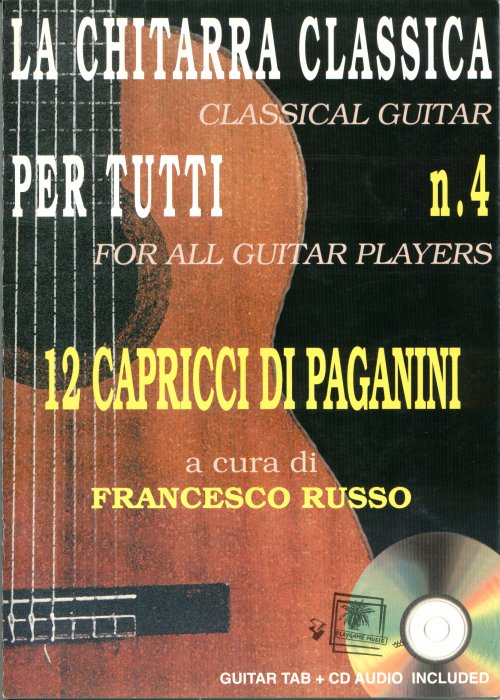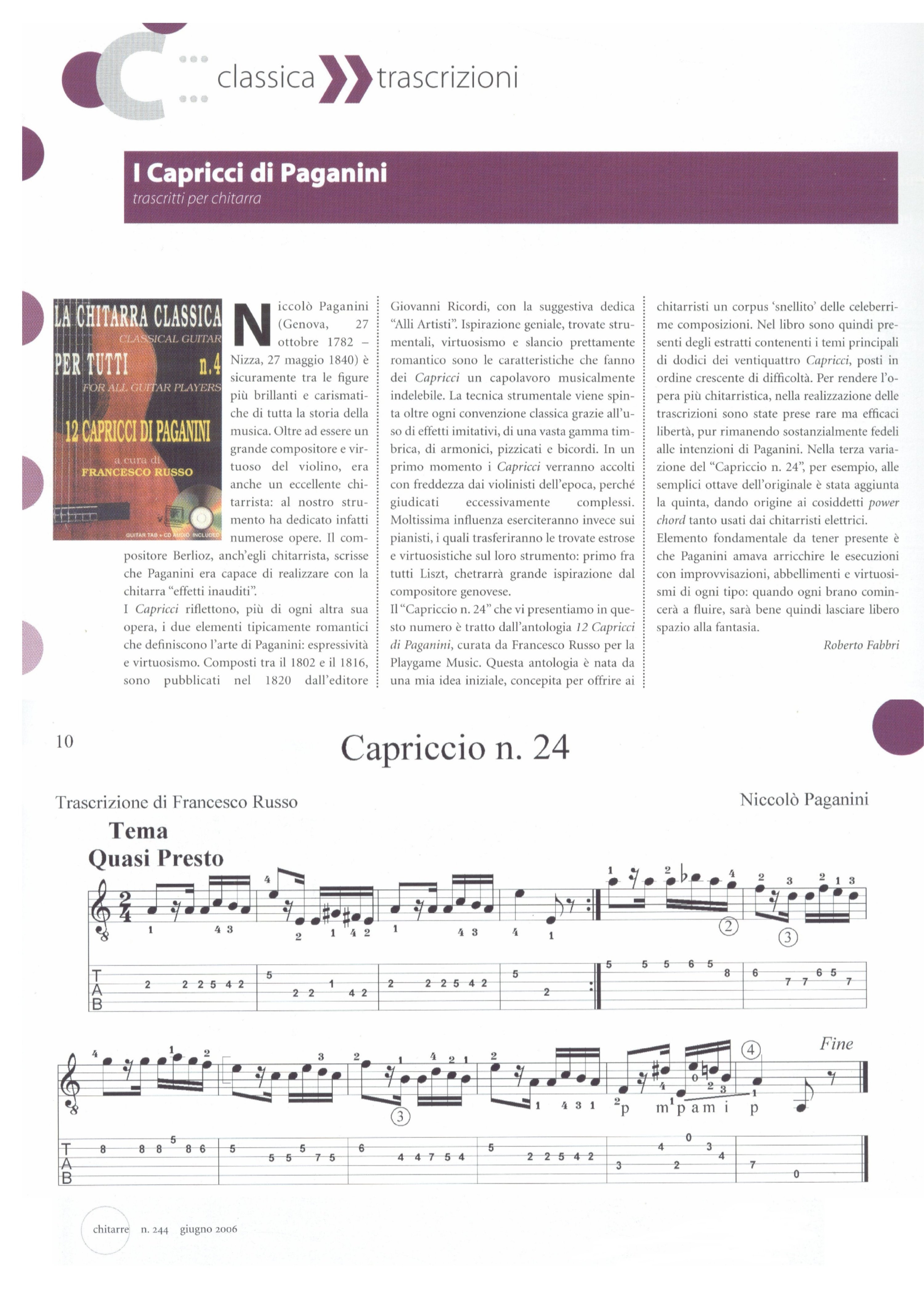
home biografia pubblicazioni musiche foto riviste f.a.q. animate caricature collana manutenzione liuteria programmi links Morricone curiosità Piero recensioni giochi video intervista postura restauro valutazione orchestra cinema play festival tipologie dvd scrivi

INTRODUZIONE
Niccolò Paganini (Genova, 27 ottobre 1782 - Nizza, 27 maggio 1840) è sicuramente tra le figure più brillanti e carismatiche di tutta la storia della musica. Oltre ad essere un grande compositore e virtuoso del violino, era anche un eccellente chitarrista: al nostro strumento ha dedicato infatti numerose opere. Il compositore Berlioz, anch’egli chitarrista, scrisse che Paganini con la chitarra era capace di realizzare “effetti inauditi”. I Capricci costituiscono l’opera che più delle altre riflettono i due elementi tipicamente romantici che caratterizzano l’arte di Paganini: espressività e virtuosismo. Composti tra il 1802 e il 1816, vengono pubblicati nel 1820 dall’editore Giovanni Ricordi con la suggestiva dedica agli artisti. Ispirazione geniale, trovate strumentali, virtuosismo e slancio prettamente romantico sono le caratteristiche che fanno dei Capricci un capolavoro musicalmente indelebile. La tecnica strumentale viene spinta oltre ogni convenzione classica grazie all’uso di effetti imitativi, di una vasta gamma timbrica, di armonici, pizzicati e bicordi. I Capricci in un primo momento verranno accolti con freddezza dai violinisti dell’epoca perché giudicati eccessivamente complessi. Moltissima influenza eserciteranno invece sui pianisti i quali trasferiranno le trovate estrose e virtuosistiche sul loro strumento: primo fra tutti Liszt il quale trarrà grande ispirazione dal compositore genovese. Nel presente lavoro sono stati trascritti 12 dei 24 Capricci e posti in ordine crescente di difficoltà. Per rendere l’Opera più chitarristica, nella realizzazione delle trascrizioni sono state prese rare ma efficaci libertà, pur rimanendo sostanzialmente fedeli alle intenzioni di Paganini; nella terza variazione del Capriccio n. 24, ad esempio, alle semplici ottave dell’originale è stata aggiunta la quinta dando origine ai power chord tanto usati dai chitarristi elettrici. Elemento fondamentale da tener presente è che Paganini amava arricchire le esecuzioni con improvvisazioni, abbellimenti e virtuosismi di ogni tipo: quando ogni brano comincerà a fluire sarà bene quindi lasciare libero spazio alla fantasia.
Roberto Fabbri
INTRODUCTION
Niccolò Paganini (Genova, 27 October 1782 - Nice, 27 may 1840) is without doubt one of the most brilliant and charismatic characters in the history of music. Besides being a great composer and a violin virtuoso, he was also an excellent guitar player. In fact, he dedicated several compositions to our instrument, the guitar. Berlioz, himself a composer and a guitar player, wrote that Paganini was able to realize “unbelievable effects” on the guitar. The Capricci, more than other works, focus on the two most typically romantic aspects of Paganini’s art: expressivity and virtuosity. They were composed between 1802 and 1816, and published in 1820 by the music publisher Giovanni Ricordi, with a fancy dedication agli artisti (“to my fellow artists”). Inspiration, new instrumental tricks, virtuosity, and a very romantic momentum are all typical characteristics of these pieces, making the Capricci a permanent, timeless, masterpiece. Paganini’s instrumental technique went beyond any classical convention, using a vast array of imitation effects, timbres, harmonics, pizzicato, and two-string play. The Capricci were at first coldly received by Paganini’s contemporary violinists, because they seemed too complex and unusual. On the other hand, they had immediate influence on piano artists. Pianists liked to transfer to their polyphonic instrument the innovative and virtuoso ideas contained in these musical works: first among them was Liszt, who took great inspiration from the Genoese violin composer. In our work, we have transcribed 12 of the 24 Capricci. They have been placed in ascending order of technical difficulty. Very occasionally, to make these transcriptions more suitable for the guitar, we have deviated a bit from the letter of the original text, but we believe that we have managed to stay close to the spirit of Paganini’s musical intentions. As an example: in the third variation of Capriccio n. 24, we added a fifth to the octaves in the original, thus producing the same power chords often effectively used by electric guitar players. We should also keep some perspective when facing transcribing dilemmas: Paganini himself loved to enrich his compositions with improvisations, embellishments, and virtuoso variations of many kinds. When a guitar transcription starts “swinging,” it is wise to leave some space for musical fantasy.
Roberto Fabbri
INDICE – TAVOLA SINTETICA / INDEX – SYNTHETIC TABLE
|
Capriccio |
Pag.
|
Track Time |
Original tonality |
Transcribed tonality |
Tempo Agogica |
Note - Osservazioni |
Notes - Observations |
|
n. 9 |
3 |
1 1’47 |
E Mi |
D Re |
2/4 Allegretto |
sottotitolo: La Caccia, terze, imitativo |
nicknamed: The Hunt, thirds, imitational |
|
n. 1 |
4 |
2 1’33 |
E Mi |
C Do |
2/2 Andante |
arpeggio veloce, barrè |
fast arpeggio, bar chords |
|
n. 10 |
5 |
3 1’42 |
G m Sol m |
E m Mi m |
6/8 Vivace |
scale, ottave |
scales, octaves |
|
n. 2 |
6-7 |
4 1’25 |
B m Si m |
E m Mi m |
6/8 Moderato |
bachiano, a 2 voci, ottave, terze |
bach-like, 2 voices, octaves, thirds |
|
n. 20 |
8 |
5 2’21 |
D Re |
D Re |
6/8 Allegretto |
a-b-a, (6) =Re/D, seste, decime, mordente |
a-b-a, (6) =D, sixths, tenths, mordente |
|
n. 5 |
9 |
6 2’32 |
A m La m |
A m La m |
4/4 Agitato |
arpeggio, scala cromatica, scala minore arm. e nat. |
arpeggio, chromatic scale, minor harm. and nat. scale |
|
n. 24 |
10-11 |
7 3’07 |
A m La m |
A m La m |
2/4 Quasi presto |
tema con variazioni, acciaccature, power chord |
theme with variations, acciaccature, power chords |
|
n. 18 |
12 |
8 1’24 |
C Do |
G Sol |
6/8 Corrente 4/4 Allegro |
a-b-a, arpeggio, armonici, terze |
a-b-a, arpeggios, harmonics, thirds |
|
n. 8 |
13 |
9 1’58 |
Eb Mib |
C Do |
4/4 Maestoso |
ottave, scale, terze, legati |
octaves, scales, thirds, hammer-on, pull-off |
|
n. 11 |
14 |
10 2’14 |
C Do |
C Do |
3/4 Andante 2/2 Presto |
a-b-a, progressioni |
a-b-a, progressions |
|
n. 4 |
15 |
11 2’40 |
C m Do m |
A m La m |
2/2 Maestoso |
a-b-a, ottave, terze |
a-b-a, octave, thirds |
|
n. 3 |
16 |
12 1’51 |
E m Mi m |
E m Mi m |
4/4 Sostenuto 3/4 Presto |
a-b-a, ottave, cromatismi, trillo, legati |
a-b-a, octaves, chromatisms, trillo, hammer-on, pull-off |
Per gentile concessione della Playgame Music ascoltiamo il file mp3: Capriccio n. 2

12 Capricci di Paganini - GuitArt n. 41 - gennaio/marzo 2006 pag. 47

12 Capricci di Paganini - Chitarre n. 244 - giugno 2006 pag. 116, 117, 118